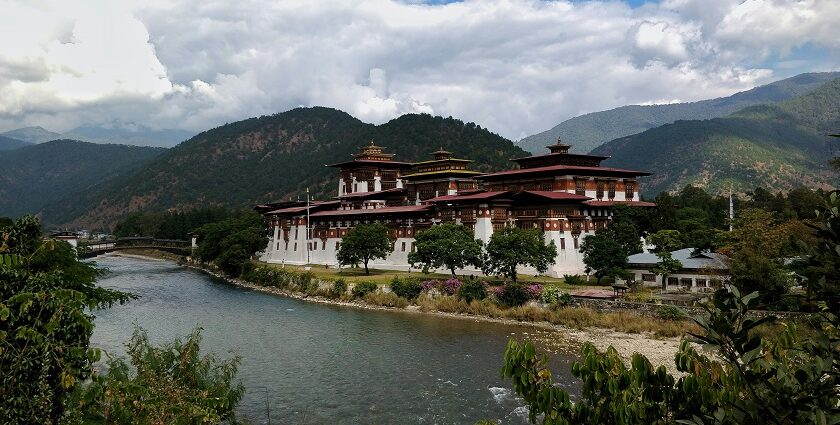Places to visit in Bhutan in August offer a mix of misty trails, lush valleys, and spiritual calm. August brings out a rare charm in Bhutan’s landscapes with rivers running fuller, forests breathing fresher, and village life. Tourist traffic is lighter, which means travellers get more peaceful experiences across major attractions. From the monastery steps of Paro and mist-covered trails in Gangtey to open markets in Thimphu, Bhutan, in August is alive in a quieter way. This is a good month for cultural visits, scenic drives, and offbeat exploration without the rush.
10 Places To Visit In Bhutan In August
These places to visit in Bhutan in August bring thick greenery, quiet roads, and fewer tourists.
1. Paro Valley
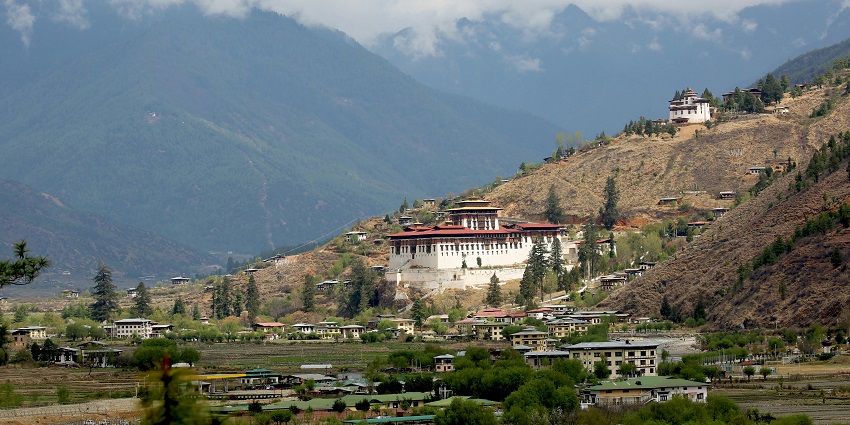
Paro Valley is one of the most scenic places to visit in Bhutan in August, with important religious and historical sites remaining open to visitors throughout the month. The trail to Tiger’s Nest is accessible. The view from the monastery, even with clouds below, is still dramatic. Rinpung Dzong and Ta Dzong function on regular timings and are never overcrowded in August. Monsoon showers bring out the deepest green across the valley. Small roadside cafés and family-run restaurants in Paro Town serve seasonal buckwheat pancakes, yak cheese dishes, and butter tea.
Location: Western Bhutan
Timings: 9 AM – 5 PM
Cost: ₹1200 – 1500
2. Thimphu City
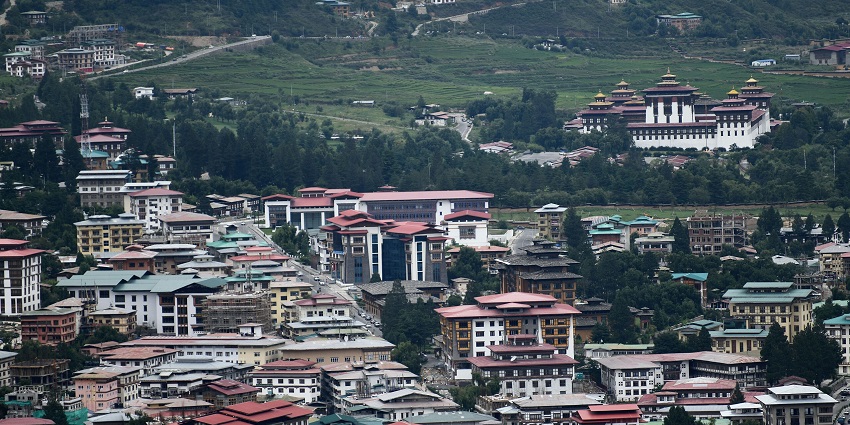
Photo: Christopher J. Fynn / Wikimedia Commons
The National Memorial Chorten remains active, and Buddha Dordenma can be visited. For travellers looking to stay indoors during downpours, the Folk Heritage Museum and the Royal Textile Academy offer detailed displays on Bhutanese traditions, tools, and textiles. Tashichho Dzong allows visitors during weekends and non-working hours. Norzin Lam is the main commercial street, where travellers can walk between local shops, handicraft stores, and eateries. The Weekend Market runs regularly from Friday to Sunday and is known for its range of organic vegetables, spices, incense sticks, and handwoven baskets. Thimphu stays connected by road throughout August, making travel within the city simple and comfortable.
Location: Western Bhutan
Timings: 8 AM – 6 PM
Cost: ₹500 for Tashichho Dzong & ₹100 for Folk Heritage Museum
3. Punakha Region
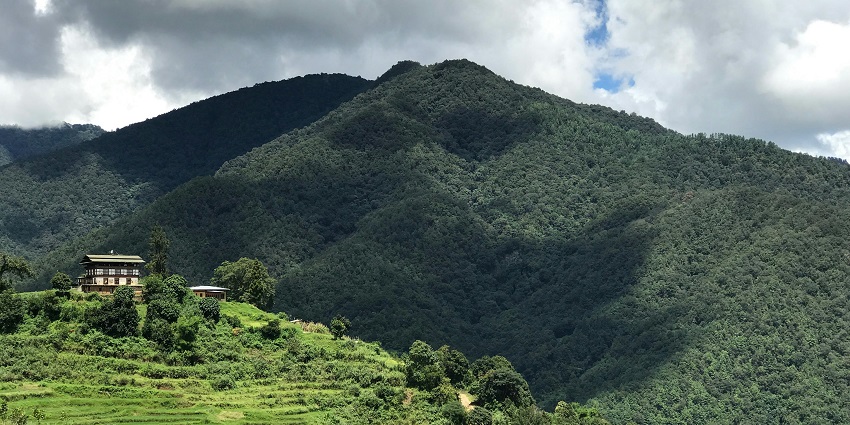
Punakha stands out among the places to visit in Bhutan in August due to its lower altitude and steady weather. The drive through misty Dochula Pass remains scenic, and the Punakha Dzong looks stunning with rain-washed jacaranda trees around it. Its interiors stay dry and accessible. You can walk across the Pho Chhu Suspension Bridge and hike through muddy rice fields to reach Chimi Lhakhang, a welcoming shrine. Local homestays and riverside cafés stay open, offering warm Bhutanese meals and peaceful views of the swollen river.
Location: West-central Bhutan
Timings: 9 AM – 5 PM
4. Bumthang District
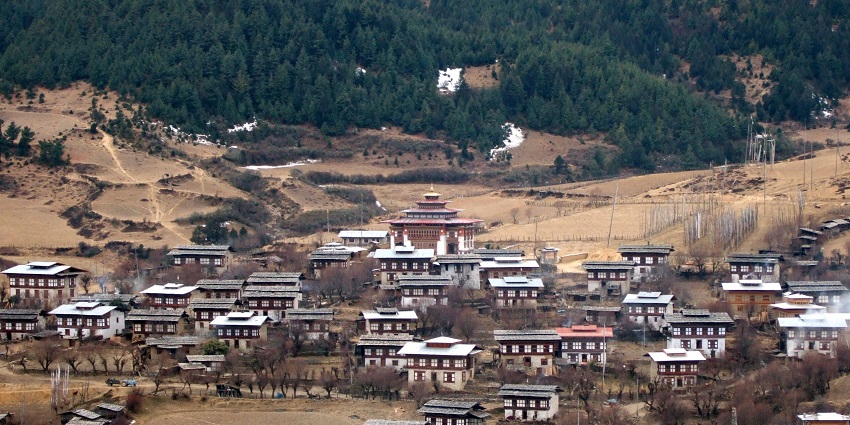
Photo: Christopher J. Fynn / Wikimedia Commons
Bumthang remains one of the most culturally rich places to visit in Bhutan in August, with valleys that stay green and quiet throughout the rainy season. The district includes four valleys: Chokhor, Tang, Ura, and Chhume, all connected by roads that remain accessible. Jakar Dzong stays open, and the view from its walls overlooks fields turning lush after every downpour. Kurjey Lhakhang and Jambay Lhakhang are both active religious sites and remain open. August also brings local festivals at smaller temples, which are open to anyone who arrives. Local restaurants serve red rice with fresh wild mushrooms.
Location: Central Bhutan
Cost: ₹300 – 1000
5. Phobjikha Valley
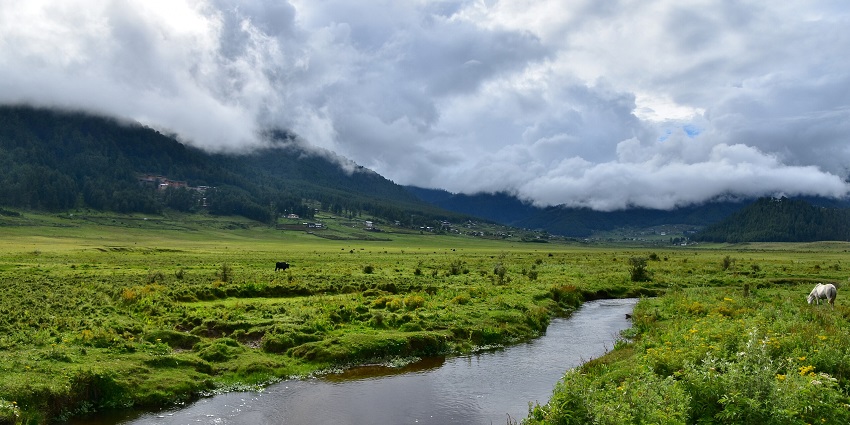
Photo: Prof. Mortel / Wikimedia Commons
Phobjikha Valley is one of the most atmospheric places to visit in Bhutan, with its wide open landscapes transformed by steady rain and low-hanging clouds. Though known for black-necked cranes in winter, August reveals a quieter side of the valley. The Gangtey Nature Trail is open and walkable, passing through pine forests and small villages. Gangtey Monastery stands at the head of the valley and remains open for visitors throughout the day, with monks continuing their daily prayers in the main courtyard. The Black-Necked Crane Visitor Centre provides information on local conservation efforts. Small lodges often serve hot suja (butter tea) and seasonal mushroom dishes.
Location: Wangdue Phodrang District
Timings: 9 AM – 5 PM
Cost: ₹100 – 300 for Gangtey Monastery & Black-Necked Crane Visitor Centre
6. Haa Valley
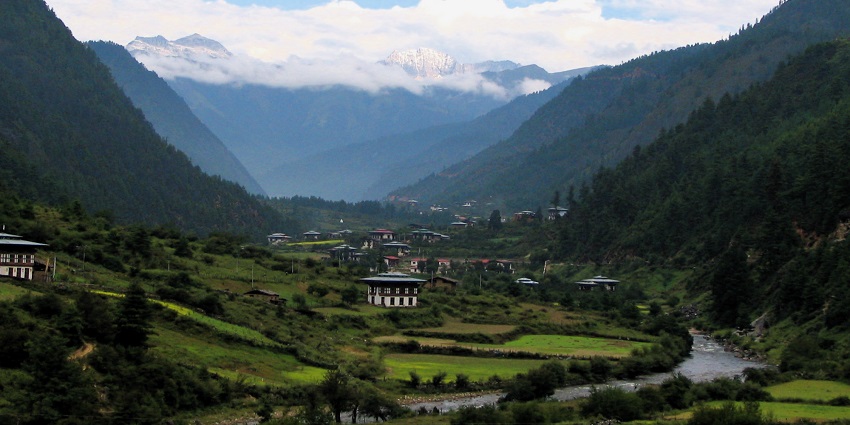
Photo: Greenmnm69 / Wikimedia Commons
Haa Valley is one of the places to visit in Bhutan during the monsoon. Rainfall brings out the deep green in its forests, while the fields surrounding the villages fill with barley and millet. The valley remains open to travellers, with Lhakhang Karpo and Lhakhang Nagpo operating as usual for visitors. These temples, known for their white and black exteriors, can be reached by short walks from the main town. Local homes in the valley offer homestay experiences, especially for those who want to explore traditional Bhutanese life.
Location: Western Bhutan, near Paro
Timings: 24*7
Cost: ₹1000
7. Trongsa District
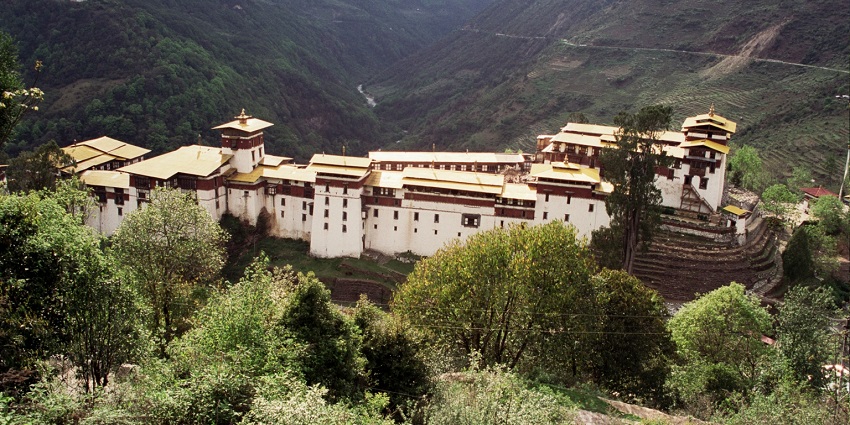
Photo: William L. Devanney / Wikimedia Commons
Trongsa is one of the most strategically located places to visit in Bhutan in August, positioned at the centre of the country and linked by well-maintained roads that remain open during monsoon. The main draw is Trongsa Dzong, the largest fortress in Bhutan, which stretches along a ridge overlooking the Mangde River. The interiors of the dzong remain accessible and dry, with murals and courtyards worth taking time to explore. Nearby, the Ta Dzong watchtower has been converted into a museum and stays open with exhibits on royal history, ancient armour, and Buddhist relics.
Location: Central Bhutan
Timings: 9 AM – 5 PM
Cost: ₹500 – 1000
8. Wangdue Phodrang Region
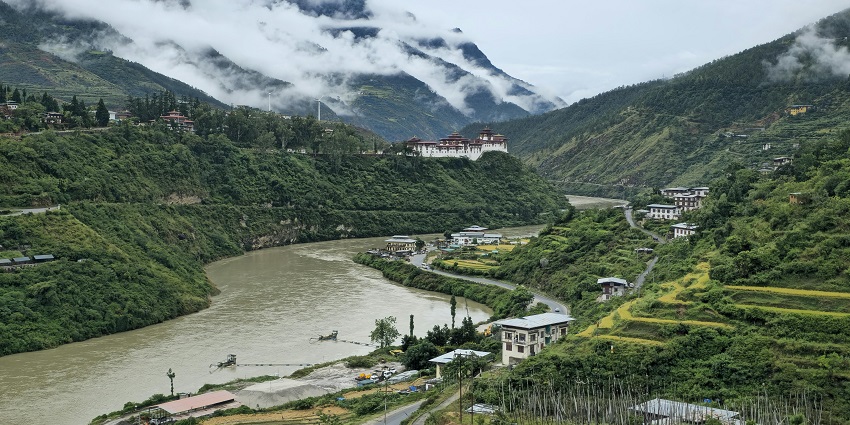
Photo: Phuntsho Wangdi / Pexels
Wangdue Phodrang remains one of the lesser-visited yet meaningful places to visit in Bhutan in August, especially for travellers looking to explore heritage and rural life without busy crowds. Take a short uphill walk to the Rinchengang Village, known for its traditional stone masonry and compact cluster of homes. In August, the surrounding slopes are rich with rain-fed vegetation, and the Puna Tsang Chhu river flows steadily along the valley floor. Travellers often stop here en route to Gangtey or central Bhutan, but those who stay overnight will find family-run lodges offering home-cooked meals and sweeping views of the valley.
Location: Central Bhutan
Timings: 9 AM – 5 PM
Cost: ₹300 – 1000
9. Mongar District
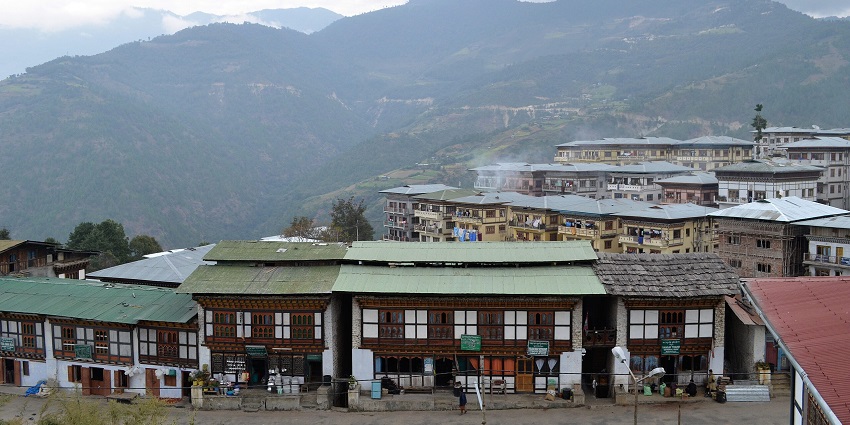
Photo: Christopher J. Fynn / Wikimedia Commons
Mongar is one of the places to visit in Bhutan, offering a mix of modern town infrastructure and remote hillside scenery. The district is connected via the East-West highway. Mongar Dzong stands on a gentle slope and remains open to visitors during the day. Unlike older dzongs, this one was built in the 20th century, but it follows the same architectural style and functions as the administrative centre of the region. The town’s markets are active year-round and feature local textiles, pickled vegetables, and seasonal herbs. Travellers passing through can explore viewpoints along the Yadi Loops, a series of sharp turns offering panoramic views of the eastern mountains.
Location: Eastern Bhutan
Timings: 8 AM – 6 PM
Cost: ₹500 – 1000
10. Lhuntse District
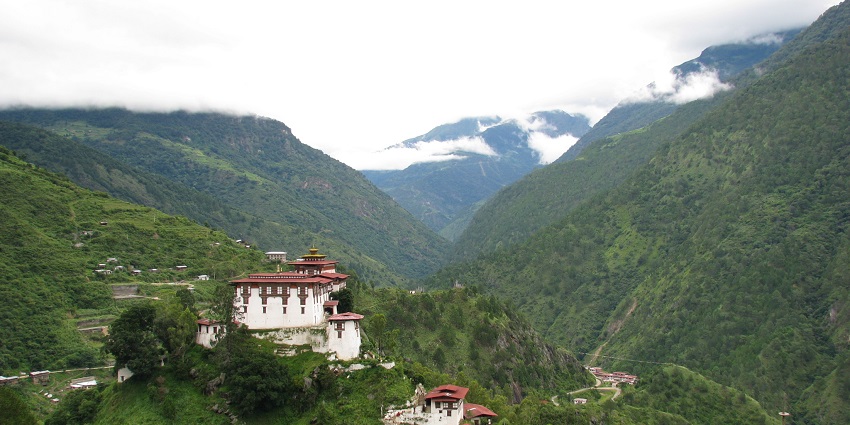
Photo: muddum27 / Wikimedia Commons
Lhuntse is one of the most untouched places to visit in Bhutan in August. It offers deep cultural roots and scenic countryside. Reaching the district requires a scenic drive from Mongar. The main attraction is Lhuentse Dzong, high above the Kuri Chhu river, and it remains open throughout the day. The dzong is still active, with local monks following their daily rituals, and the site overlooks cliffs wrapped in mist. Khoma Village, nearby, is the centre of Bhutan’s traditional Kishuthara weaving, and travellers can visit workshops where artisans continue their work. August also brings vibrant greenery to the valley, with fields bordered by maize and flowering plants.
Location: Northeastern Bhutan
Timings: 9 AM – 5 PM
Travelling through the places to visit in Bhutan in August offers a unique, serene experience. Valleys turn lush green, trails grow quieter, and the slower pace lets you take in the finer details. Temples stay open, dzongs carry on with daily rituals, and everyday life flows calmly. With fresh produce and uncrowded sights, Bhutan feels truly alive. Planning a monsoon getaway? Start your journey with TripXL today.
Cover Photo: Tanay Dedhia / Unsplash


 WhatsApp
WhatsApp
 Twitter
Twitter
